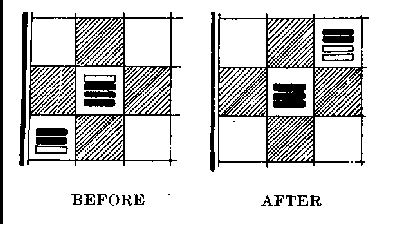
Stack-Up is a variation of checkers in which no pieces are removed from the board, the jumping piece accumulating one (and only one) enemy checker at each jump. The captured checker is removed from the top of the jumped stack and placed at the bottom of the jumping stack, as illustrated in the diagram. A single man when jumped is put under the jumping piece, leaving the square it occupied vacant. A stack belongs to the player whose color appears at the top of it. The game is won by the player who succeeds in covering all his opponent's men.

| An example of a jump in Stack-Up Checkers. At the left, a "black" stack attacks a "white" stack, the colors being determined by the topmost checker. At the right is the situation after the jump--- the top checker of the "captured" stack is transferred to the bottom of the jumping stack, and the former thereby becomes "black." |
The general procedure of checkers applies, except for the following necessary arbitrary rules:
(a) The game divides naturally into two parts, say, opening and end-game. In the opening it is desirable to force the opponent to capture successively with the same piece as large a number as possible of your own checkers, provided that at the end of the sequence the stack so built up is in hock. Your recapture will now leave a solid stack of your own color, the virtues of which cannot be exaggerated. Such a piece will be able to wear down any opposing stack of lesser height in forced marches up and down the board and still remain your piece for as many captures and recaptures as there are layers to the stack.
In the end-game the main job is to hunt down with these powerhouses all the opponent's unfit survivals, while protecting anything you have in the way of top-heavy accumulations of his men under a single or double icing of your own pieces.
(b) It is generally to your advantage to keep as large a number of pieces as possible regardless of size, while whittling down the number of your opponent's. The point of this is that toward the end of the game a good many squeezes can be applied, or you may be saved by the simple inability of the enemy to find a stalling move in an otherwise winning position. Of course this principle is more or less inconsistent with the important one above, and can be applied only with discretion and where other considerations are pretty much equal.
The invention of the game may or may not be credited to Mr. Mark Eudey and myself. Nobody else around here has seen it before, but it is not unlikely that Mr. Eudey's cobwebbed memory is more to be credited than his genius. My only claim is to the contribution of some of the arbitrary rules.
Copyright (C) 1938, Stillman Drake; 1997, Daniel Drake. A royalty-free license to reproduce this document in whole or in part is hereby granted provided (i) all additions, omissions, and other changes are clearly marked; (ii) the work is not reproduced as, or as part of, a work for which payment is charged; (iii) this notice is reproduced without change. Quotations for critical or polemical purposes, with proper attribution, are permitted in any case, being obviously fair use.